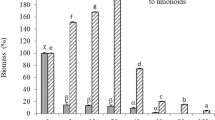Summary
Cultured cells of Lavandula vera were entrapped with photosensitive synthetic resin prepolymers (PVA-SbQ). PVA-SbQ-entrapped cells grew well inside gel matrices and synthesized de novo blue pigments in the presence of l-cysteine as an inducer. The entrapped cells were superior to calcium alginate-entrapped cells judging from cell growth and total pigment productivity. Release of the pigments, which were almost insoluble in water, from the gels was markedly enhanced by the increase in hydrophilicity of the cell-entrapping gels. The entrapped cells could be used repeatedly for the pigment production.
Similar content being viewed by others
References
Brodelius P (1985) Immobilized plant cells. In: Laskin AI (ed) Enzymes and immobilized cells in biotechnology. Benjamin/Cummings, California, p 109
Brodelius P, Nilsson K (1980) Entrapment of plant cells in different matrices. A comparative study. FEBS Lett 122:312–316
Fukui S, Tanaka A, Iida T, Hasegawa E (1976) Application of photo-crosslinkable resin to immobilization of an enzyme. FEBS Lett 66:179–182
Fukushima S, Nagai T, Fujita K, Tanaka A, Fukui S (1978) Hydrophilic urethane prepolymers: Convenient materials for enzyme entrapment. Biotechnol Bioeng 20:1465–1469
Galun E, Aviv D, Dantes A, Freeman A (1983) Biotransformation by plant cells immobilized in cross-linked polyacrylamide-hydrazide. Planta Med 49:9–13
Ichimura K (1984) A convenient photochemical method to immobilize enzymes. J Polym Sci Polym Chem Ed 22:2817–2828
Lindsey K, Yeoman MM, Black GM, Mavituna F (1983) A novel method for the immobilisation and culture of plant cells. FEBS Lett 155:143–149
Linsmaier EM, Skoog F (1965) Organic growth factor requirements of tobacco tissue cultures. Physiol Plant 18:100–127
Mavituna F, Park JM (1985) Growth of immobilized plant cells in reticulate polyurethane foam matrices. Biotechnol Lett 7:637–640
Nakajima H, Sonomoto K, Usui N, Sato F, Yamada Y, Tanaka A, Fukui S (1985) Entrapment of Lavandula vera cells and production of pigments by entrapped cells. J Biotechnol 2:107–117
Rosevear A, Lambe CA (1985) Immobilized plant cells. Adv Biochem Eng/Biotechnol 31:37–58
Watanabe K, Sato F, Furuta M, Yamada Y (1985) Induction of pigment production by S-containing compounds in cultured Lavandula vera cells. Agric Biol Chem 49:533–534
Watanabe K, Yamada Y (1982) Selection of variants with high level of biotin from cultured green Lavandula vera cells irradiated with gamma rays. Plant Cell Physiol 23:1453–1456
Watanabe K, Yano S, Yamada Y (1982) The selection of cultured plant cell lines producing high level of biotin. Phytochem 21:513–516
Author information
Authors and Affiliations
Additional information
Dedicated to Professor Dr. Georg Manecke on occasion of his 70th birthday
Rights and permissions
About this article
Cite this article
Nakajima, H., Sonomoto, K., Morikawa, H. et al. Entrapment of Lavandula vera cells with synthetic resin prepolymers and its application to pigment production. Appl Microbiol Biotechnol 24, 266–270 (1986). https://doi.org/10.1007/BF00257047
Received:
Revised:
Issue Date:
DOI: https://doi.org/10.1007/BF00257047




